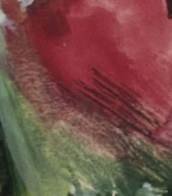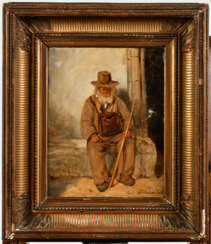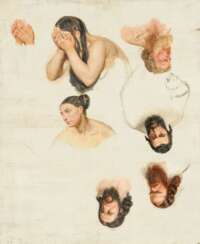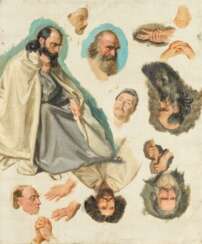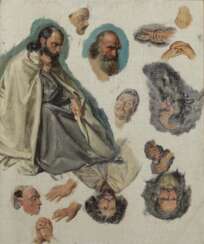поль деларош (1797 - 1856)
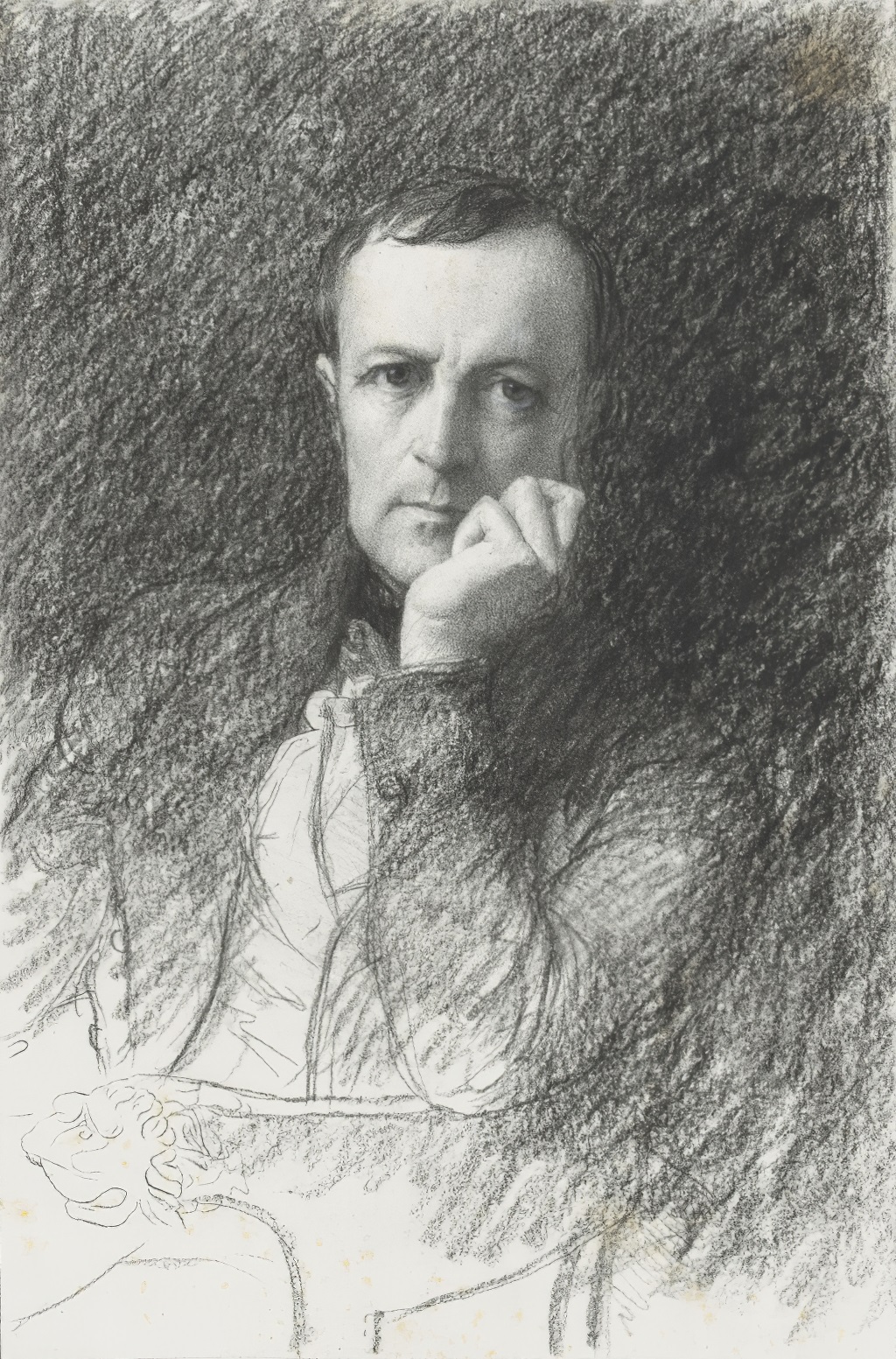
Paul Delaroche was renowned for his meticulously detailed historical scenes that captured both the essence and drama of bygone eras. Delaroche's work bridged the Neoclassical and Romantic movements, bringing to life figures and moments from both English and French history with a narrative intensity that resonated across Europe.
Paul Delaroche's education under the influential history painters Antoine-Jean Gros and Watelet instilled in him a profound understanding of historical accuracy and dramatic composition. His debut at the Paris Salon in 1822 marked the beginning of a highly successful career in which he received widespread acclaim, particularly for his poignant portrayal of "The Execution of Lady Jane Grey" in 1834, a piece that remains one of his most celebrated works.
Throughout his career, Paul Delaroche was committed to the educational aspect of art. In 1833, he became a professor at the École des Beaux-Arts in Paris, influencing a generation of artists with his emphasis on historical fidelity and narrative depth. His major works, like the grand mural "The Hemicycle," which he completed between 1837 and 1841, showcased his talent for orchestrating large-scale compositions that featured an array of historical figures.
Paul Delaroche's approach to history painting was characterized by a "philosophical analysis" of events, aiming to link historical truth with the nineteenth-century understanding of time and morality. His attention to detail and the emotional gravity of his subjects helped forge a visceral connection with viewers, making his works a staple in both public exhibitions and private collections.
For collectors and enthusiasts wishing to delve deeper into Delaroche's legacy or view his works, ongoing exhibitions and collections can be accessed through various art galleries and museums worldwide. To stay informed about such events and opportunities, consider signing up for updates focused on Paul Delaroche's works and their exhibition schedules.
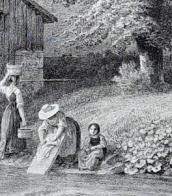

Paul Delaroche was renowned for his meticulously detailed historical scenes that captured both the essence and drama of bygone eras. Delaroche's work bridged the Neoclassical and Romantic movements, bringing to life figures and moments from both English and French history with a narrative intensity that resonated across Europe.
Paul Delaroche's education under the influential history painters Antoine-Jean Gros and Watelet instilled in him a profound understanding of historical accuracy and dramatic composition. His debut at the Paris Salon in 1822 marked the beginning of a highly successful career in which he received widespread acclaim, particularly for his poignant portrayal of "The Execution of Lady Jane Grey" in 1834, a piece that remains one of his most celebrated works.
Throughout his career, Paul Delaroche was committed to the educational aspect of art. In 1833, he became a professor at the École des Beaux-Arts in Paris, influencing a generation of artists with his emphasis on historical fidelity and narrative depth. His major works, like the grand mural "The Hemicycle," which he completed between 1837 and 1841, showcased his talent for orchestrating large-scale compositions that featured an array of historical figures.
Paul Delaroche's approach to history painting was characterized by a "philosophical analysis" of events, aiming to link historical truth with the nineteenth-century understanding of time and morality. His attention to detail and the emotional gravity of his subjects helped forge a visceral connection with viewers, making his works a staple in both public exhibitions and private collections.
For collectors and enthusiasts wishing to delve deeper into Delaroche's legacy or view his works, ongoing exhibitions and collections can be accessed through various art galleries and museums worldwide. To stay informed about such events and opportunities, consider signing up for updates focused on Paul Delaroche's works and their exhibition schedules.


Paul Delaroche was renowned for his meticulously detailed historical scenes that captured both the essence and drama of bygone eras. Delaroche's work bridged the Neoclassical and Romantic movements, bringing to life figures and moments from both English and French history with a narrative intensity that resonated across Europe.
Paul Delaroche's education under the influential history painters Antoine-Jean Gros and Watelet instilled in him a profound understanding of historical accuracy and dramatic composition. His debut at the Paris Salon in 1822 marked the beginning of a highly successful career in which he received widespread acclaim, particularly for his poignant portrayal of "The Execution of Lady Jane Grey" in 1834, a piece that remains one of his most celebrated works.
Throughout his career, Paul Delaroche was committed to the educational aspect of art. In 1833, he became a professor at the École des Beaux-Arts in Paris, influencing a generation of artists with his emphasis on historical fidelity and narrative depth. His major works, like the grand mural "The Hemicycle," which he completed between 1837 and 1841, showcased his talent for orchestrating large-scale compositions that featured an array of historical figures.
Paul Delaroche's approach to history painting was characterized by a "philosophical analysis" of events, aiming to link historical truth with the nineteenth-century understanding of time and morality. His attention to detail and the emotional gravity of his subjects helped forge a visceral connection with viewers, making his works a staple in both public exhibitions and private collections.
For collectors and enthusiasts wishing to delve deeper into Delaroche's legacy or view his works, ongoing exhibitions and collections can be accessed through various art galleries and museums worldwide. To stay informed about such events and opportunities, consider signing up for updates focused on Paul Delaroche's works and their exhibition schedules.


Paul Delaroche was renowned for his meticulously detailed historical scenes that captured both the essence and drama of bygone eras. Delaroche's work bridged the Neoclassical and Romantic movements, bringing to life figures and moments from both English and French history with a narrative intensity that resonated across Europe.
Paul Delaroche's education under the influential history painters Antoine-Jean Gros and Watelet instilled in him a profound understanding of historical accuracy and dramatic composition. His debut at the Paris Salon in 1822 marked the beginning of a highly successful career in which he received widespread acclaim, particularly for his poignant portrayal of "The Execution of Lady Jane Grey" in 1834, a piece that remains one of his most celebrated works.
Throughout his career, Paul Delaroche was committed to the educational aspect of art. In 1833, he became a professor at the École des Beaux-Arts in Paris, influencing a generation of artists with his emphasis on historical fidelity and narrative depth. His major works, like the grand mural "The Hemicycle," which he completed between 1837 and 1841, showcased his talent for orchestrating large-scale compositions that featured an array of historical figures.
Paul Delaroche's approach to history painting was characterized by a "philosophical analysis" of events, aiming to link historical truth with the nineteenth-century understanding of time and morality. His attention to detail and the emotional gravity of his subjects helped forge a visceral connection with viewers, making his works a staple in both public exhibitions and private collections.
For collectors and enthusiasts wishing to delve deeper into Delaroche's legacy or view his works, ongoing exhibitions and collections can be accessed through various art galleries and museums worldwide. To stay informed about such events and opportunities, consider signing up for updates focused on Paul Delaroche's works and their exhibition schedules.
